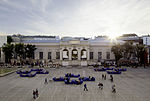Volkstheater, Vienna

The Volkstheater in Vienna (roughly translated as "People's Theatre") was founded in 1889 by request of the citizens of Vienna, amongst them the dramatist Ludwig Anzengruber and the furniture manufacturer Thonet, in order to offer a popular counter weight to the Hofburgtheater. It was erected according to designs by Ferdinand Fellner and Hermann Helmer, who attempted to reconcile their plans with historicism. It is located in Neubau, the seventh district of Vienna. The founders of this stage had a theatrical stage in mind, in order to expose wider circles of the population of Vienna to classical and modern literature whilst staging these next to more traditional plays. The theatre follows this tradition even today. New productions of the classics are always in the pipeline along with regular reinterpretations of works by Ferdinand Raimund and Johann Nestroy and many new plays and reruns. Special attention is given to Austrian playwrights of old and new. In 2005 Michael Schottenberg became art director of the Volkstheater. In 2005 the Volkstheater started an alternative theater stage called "Volkstheater Hundsturm" in Margareten, the fifth district of Vienna. It is a place for experimental theater (e.g. Wojtek Klemm, Dejan Dukovski, monochrom). The Volkstheater station of lines U2 and U3 of the Vienna U-Bahn is located here.
Excerpt from the Wikipedia article Volkstheater, Vienna (License: CC BY-SA 3.0, Authors, Images).Volkstheater, Vienna
Arthur-Schnitzler-Platz, Vienna Spittelberg (Neubau)
Geographical coordinates (GPS) Address Website External links Nearby Places Show on map
Geographical coordinates (GPS)
| Latitude | Longitude |
|---|---|
| N 48.205277777778 ° | E 16.356666666667 ° |
Address
Volkstheater
Arthur-Schnitzler-Platz 1
1070 Vienna, Spittelberg (Neubau)
Austria
Open on Google Maps











